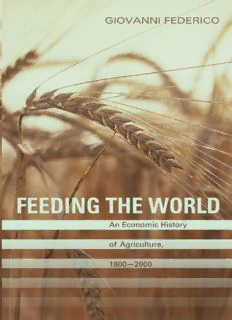
Feeding the World An Economic History of Agriculture, 1800-2000 PDF
Preview Feeding the World An Economic History of Agriculture, 1800-2000
Feeding the World THE PRINCETON ECONOMIC HISTORY OF THE WESTERN WORLD Joel Mokyr, Editor RECENT TITLES INCLUDE: Farm to Factory: A Reinterpretation of the Soviet Industrial Revolution, by Robert C. Allen Quarter Notes and Bank Notes: The Economics of Music Composition in the Eighteenth and Nineteenth Centuries, by F. M. Scherer The Strictures of Inheritance: The Dutch Economy in the Long Nineteenth-Century, by Jan Luiten van Zanden and Arthur van Riel Understanding the Process of Economic Change, by Douglass C. North Feeding the World: An Economic History of Agriculture, 1800–2000, by Giovanni Federico Cultures Merging: A Historical and Economic Critique of Culture, by Eric L. Jones The European Economy since 1945: Coordinated Capitalism and Beyond, by Barry Eichengreen War, Wine, and Taxes: The Political Economy of Anglo-French Trade, 1689–1900, by John V. C. Nye A Farewell to Alms: A Brief Economic History of the World, by Gregory Clark Power and Plenty: Trade, War, and the World Economy in the Second Millennium, by Ronald Findlay and Kevin O’Rourke Feeding the World an economic history of agriculture, 1800–2000 Giovanni Federico princeton university press princeton and oxford Copyright © 2005 by Princeton University Press Published by Princeton University Press, 41 William Street, Princeton, New Jersey 08540 In the United Kingdom: Princeton University Press, 6 Oxford Street, Woodstock, Oxfordshire OX20 1TW All Rights Reserved Second printing, and first paperback printing, 2009 Paperback ISBN: 978-0-691-13853-4 The Library of Congress has cataloged the cloth edition of this book as follows Federico, Giovanni, 1954– Feeding the world : an economic history of agriculture, 1800–2000 / Giovanni Federico. p. cm. (The Princeton economic history of the Western World) Includes bibliographical references and index. ISBN-13: 978-0-691-12051-5 (cl. : alk. paper) ISBN-10: 0-691-12051-X (cl. : alk. paper) 1. Agriculture—Economic aspects—History—19th century. 2. Agriculture—Economic aspects—History—20th century. I. Title. HD1411.F43 2005 338.1'09'034–dc22 2004058634 British Library Cataloging-in-Publication Data is available This book has been composed in Garamond Printed on acid-free paper. ∞ press.princeton.edu Printed in the United States of America 3 5 7 9 10 8 6 4 2 CONTENTS List of Illustrations ix List of Tables ix Preface xiii Chapter One Introduction 1 Chapter Two Why Is Agriculture Different? 5 2.1Introduction 5 2.2Agriculture and the Environment: An Uneasy Relationship 5 2.3Factor Endowment and the Characteristics of Agriculture 13 Chapter Three Trends in the Long Run 16 3.1Introduction 16 3.2Output 16 3.3Prices 21 3.4The Composition of Agricultural Output 26 3.5Trade 28 Chapter Four Patterns of Growth: The Inputs 31 4.1Introduction 31 4.2Land 31 4.3Capital 40 4.4Labor 56 4.5Conclusion: Factor Endowment and Factor Prices in the Long Run 64 Chapter Five The Causes of Growth: The Increase in Productivity 69 5.1Introduction 69 5.2The Productivity of Land and Labor 70 5.3The Total Factor Productivity 74 5.4Conclusion: On the Interpretation of Total Factor Productivity Growth 82 Unauthenticated Download Date | 11/5/15 2:15 AM vi CONTENTS Chapter Six Technical Progress in Agriculture 83 6.1Introduction: Productivity Growth and Technical Progress 83 6.2The Major Innovations 84 6.3The Macroeconomics of Innovations: Factor Prices and Technical Progress 93 6.4The Microeconomics of Agricultural Innovation: Appropriability, Complementarity, Environment, and Risk 101 6.5The Microeconomics of Agricultural Innovation: Research Institutions and Technical Progress 105 6.6Conclusion: On the Causes of Technical Progress 114 Chapter Seven The Microeconomics of Agricultural Institutions 117 7.1Introduction: What Are the Institutions, and Why Should We Care about Them? 117 7.2Property Rights 118 7.3The “Structure”: Matching Land and Labor 121 7.4Finding the Money: Formal and Informal Credit 128 7.5The Co-operative: The Best of All Possible Worlds? 133 7.6Conclusion: Is There an “Ideal” Farm? 136 Chapter Eight Agricultural Institutions and Growth 143 8.1Introduction 143 8.2Prelude: The Establishing of Modern Property Rights 144 8.3Meddling with Property Rights: Land Reform and Other Structural Interventions 149 8.4The “Structural” Change in the Long Run 152 8.5The Development of Markets 160 8.6Self-help: The Growth of the Co-operative Movement 168 8.7Institutions and Agricultural Growth: The Creation of Property Rights and “Structural” Interventions 172 8.8Institutions and Agricultural Growth: Landownership, Farm Size, and Contracts 177 8.9Institutions andAgricultural Growth: The Development of Markets 181 8.10Conclusion: Did Institutions Really Matter? 186 Chapter Nine The State and the Market 187 9.1Introduction: On the Design of Agricultural Policies 187 9.2Before 1914: The Era of Laissez Faire 189 9.3The Interwar Years: The Great Discontinuity 191 9.4The OECD Countries after 1945: The Era of Surpluses 196 Unauthenticated Download Date | 11/5/15 2:15 AM CONTENTS vii 9.5The Less Developed Countries after Independence: The Green Revolution and the “Development” Policies 201 9.6The Socialist Countries 205 9.7On the Effects of Agricultural Policies 211 9.8Conclusion: The Political Economy of Agricultural Policies 215 Chapter Ten Conclusions: Agriculture and Economic Growth in the Long Run 221 10.1Fifteen Stylized Facts 221 10.2Agriculture and Economic Growth: Some Theory 222 10.3Agriculture and Economic Growth: Debates and Historical Evidence 226 10.4Concluding Remarks: A Look to the Future 231 Statistical Appendix 233 Notes 251 Bibliography 325 Index 381 Unauthenticated Download Date | 11/5/15 2:15 AM This page intentionally left blank Unauthenticated Download Date | 11/5/15 2:15 AM
Description: